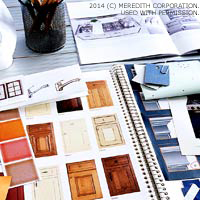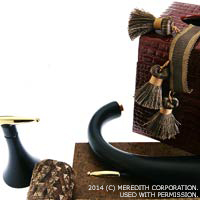You may be surprised to learn that hiring an interior designer isn’t just for the rich and famous. Prices vary widely and the scope of the work may be as simple as an hour helping you choose a paint color, or as complex as mapping out a full-room (or whole-house!) makeover. Whether you want a few hours of consultation or a total house renovation, the good news is that an experienced designer will work with your budget. To help you get started, refer to our tips to organize your ideas, map out what you want, and nail down a realistic budget.
Most people don’t realize you can call on a designer for almost any decorating need. They’ll spend an hour helping you choose color or take more time to plan a floor-to-ceiling redo.
Getting Organized

Be prepared to discuss your wishes for the project, your budget range, and a total-cost ceiling. That way, your designer can guide you on ways to economize in some areas so you can splurge on something wonderful somewhere else.
- Provide general advice and help set your priorities. A good interior designer can offer suggestions for room arrangements, color schemes, and window treatments, based on knowledge of what is available in your price range and what is appropriate for each use.
- Pull a house together. If you’ve moved your old furniture into your new house, a designer can help you bring the new look together.
- Complete a room. A designer can also help you with smaller projects, such as fine-tuning one room or decorating to include an heirloom piece of furniture.
- Coordinate a floor-to-ceiling makeover. A designer can help you create a dream come true.
- Share references for various home-improvement professionals.
- Make furniture recommendations. If your primary need is new furniture, the design services of a retail furniture store may be the easiest alternative. An on-staff designer will visit your home (usually at no cost) and help you choose furniture and determine floor plans, then arrange for your furniture purchase.
- Help you personalize your home. An interior designer can help you add the finishing touches that give a room that special “magazine look.” Some designers suggest you reserve 15-20 percent of your budget to purchase one-of-a-kind accessories that will transform a well-furnished room into a personal environment tailored to your own tastes. Keep in mind, too, that one of the advantages of using an interior designer is access to exclusive or “to-the-trade” items, including fabrics, furniture, and accessories that contribute to your home’s one-of-a-kind look.
- Work with what you have. One service that is gaining popularity is “one-day decorating.” For a one-time fee, an interior designer, often referred to as an “interior arranger,” will visit your home and offer suggestions for working with what you already own by rearranging furniture, swapping artwork between rooms, re-covering furniture, and painting walls.
Discussing Money

Above all, the relationship with your interior designer must feel right, or it won’t work. Remember, you’re working together on your private environment. Evaluate an interior designer during a getting-to-know-you interview.
The designer will come to your home for a walk-through. You can see how well the two of you communicate and consider the designer’s ideas for your home. Once you decide on a designer, it’s wise to sign a contract that clearly states the services and fees. Designers charge for their services in different ways. And, depending on your needs and the scale of the project, a designer may combine payment types. Keep in mind, too, that not every designer offers every payment option. Here are some common payment arrangements.
- Hourly fees. Be sure to understand whether this includes travel, shopping, and the like. Also ask what expenses you may be billed for during the project.
- “Cost plus,” where you pay retail prices for fabrics; the designer’s “fee” will be the difference between what you pay and the cost of the furnishings at wholesale.
- A percentage of the cost of furnishings and/or labor.
- A flat fee for the entire job.
Adapted from Better Homes and Gardens. Used with permission. ©Meredith Corporation. http://www.meredith.com. All rights reserved.


